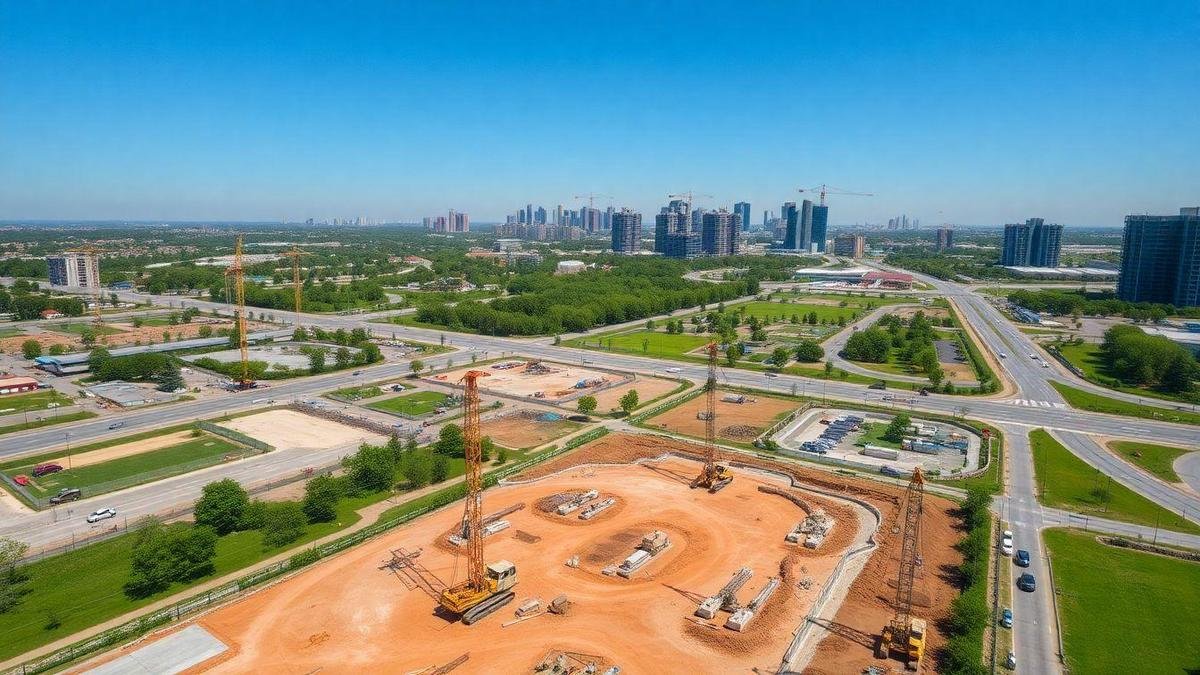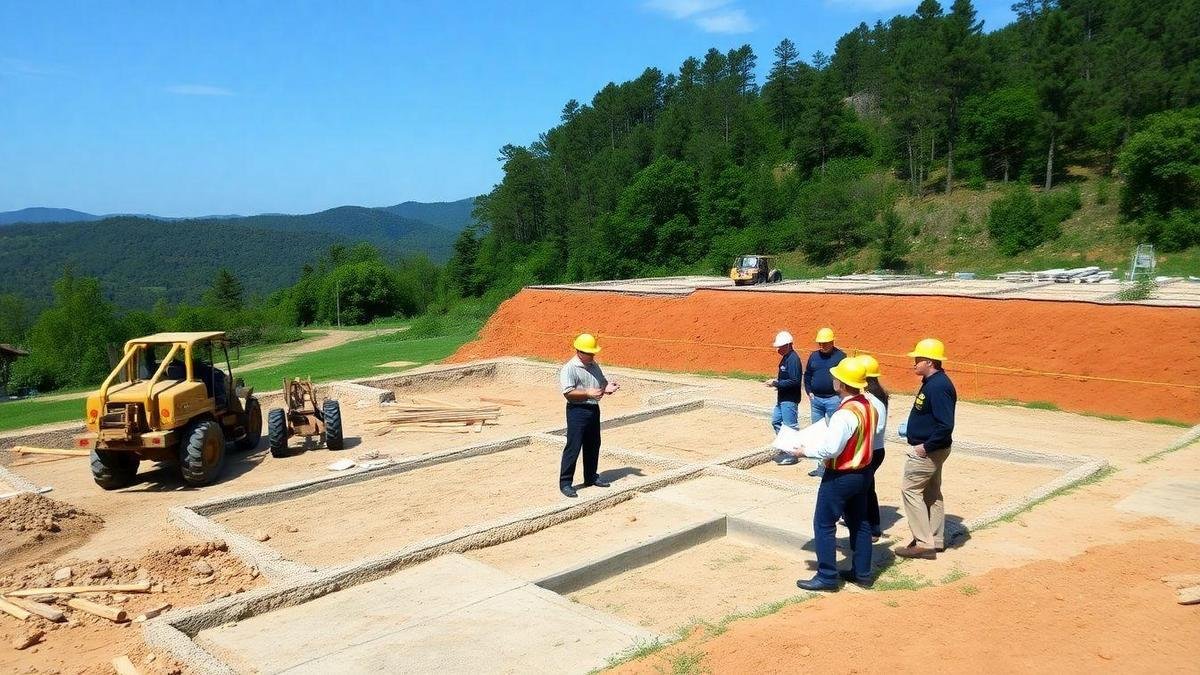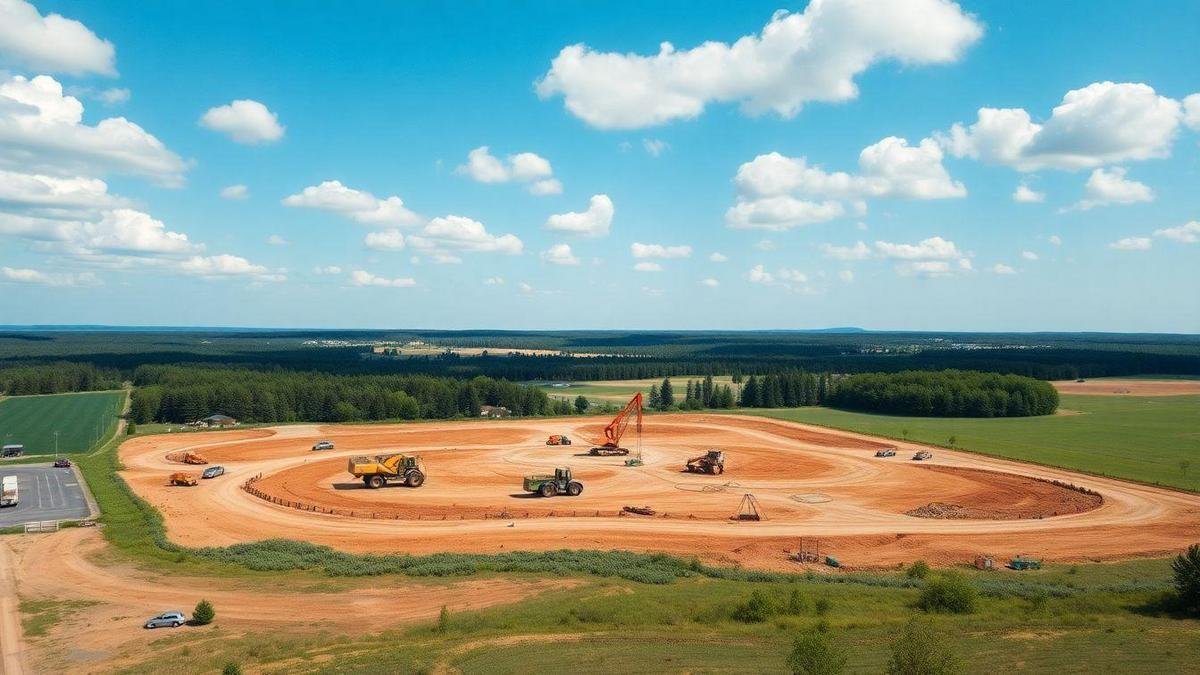In this article, readers will learn how to start land development and navigate the complexities of real estate projects. The exploration will cover essential topics such as the key steps in the development process, market demand assessment, and the importance of zoning laws and permits. Additionally, insights into financing options, land acquisition strategies, and common challenges faced by new investors will be provided. This comprehensive guide aims to equip aspiring developers with the knowledge needed to thrive in the land development landscape.
Key Learnings
- Research the land market carefully.
- Create a clear development plan.
- Understand zoning laws and regulations.
- Assess the land’s potential value.
- Build a strong team of experts.

Understanding the Basics of Land Development
What is Land Development?
Land development refers to the process of transforming land into a more usable state. This can involve residential, commercial, or industrial projects. The goal is to create spaces where people can live, work, and play. It encompasses everything from zoning laws to construction and infrastructure.
Key Steps in the Land Development Process
The land development process can be broken down into several key steps:
- Site Selection: Choosing the right piece of land is crucial. Factors like location, size, and zoning regulations play a significant role.
- Planning and Design: This involves creating a plan for how the land will be used. Architects and planners work together to design the layout.
- Permitting: Before any construction can begin, developers must obtain the necessary permits from local governments. This ensures that the project complies with local laws.
- Construction: Once permits are secured, construction can begin. This includes building infrastructure like roads and utilities.
- Marketing and Sales: After construction, the property can be marketed to potential buyers or tenants.
| Step | Description |
|---|---|
| Site Selection | Choosing the right land for development |
| Planning & Design | Creating a detailed plan for land use |
| Permitting | Obtaining necessary government approvals |
| Construction | Building infrastructure and facilities |
| Marketing & Sales | Selling or leasing the developed property |

How to Start Land Development: Initial Considerations
Assessing Market Demand for Land Development
Before diving into land development, one must first assess the market demand. Understanding the local economy can make or break a project. It is crucial to analyze trends in housing, commercial spaces, and industrial needs. Investors should look at recent sales data, population growth, and employment rates.
For example, if a city is seeing a surge in population due to new job opportunities, it may indicate a need for more housing. Investors can gather this information from local government reports, real estate agencies, and market studies.
Identifying Suitable Locations for Development
Once market demand is clear, the next step is identifying suitable locations. Not all land is created equal. Factors such as accessibility, zoning laws, and proximity to amenities play a significant role in determining a site’s viability.
Factors to Consider When Finding Land for Development
When searching for land, several key factors should be taken into account:
| Factor | Description |
|---|---|
| Zoning Regulations | Ensure the land is zoned for the intended use. |
| Accessibility | Check for nearby roads, public transport, and utilities. |
| Environmental Impact | Assess if development will affect local ecosystems. |
| Market Trends | Evaluate if the area is growing or declining. |
| Costs | Consider purchase price, taxes, and development costs. |
By focusing on these factors, investors can make informed decisions that align with their development goals.

Zoning and Permits: Essential for Land Development
Understanding Zoning Laws and Regulations
Zoning laws are rules set by local governments to control how land can be used. They dictate what can be built where, ensuring that areas are developed in a way that makes sense for the community. For instance, a residential zone may not allow factories, while commercial zones might be off-limits for homes.
Here are some key points about zoning:
- Types of Zoning: There are various types, such as residential, commercial, industrial, and agricultural. Each type has specific guidelines.
- Zoning Map: Local governments often provide a zoning map that shows what areas are designated for which uses. This map is crucial for investors to understand.
- Variances: Sometimes, a developer may want to use land in a way that doesn’t fit the zoning laws. They can apply for a variance, which is a special permission to deviate from these laws.
The Permit Application Process Explained
When a developer wants to start a project, they must go through the permit application process. This process can be lengthy and requires careful attention to detail. Here’s how it typically works:
- Pre-Application Meeting: Developers often meet with local officials to discuss their plans and get initial feedback.
- Submission of Application: After gathering all necessary documents, the developer submits their application. This includes plans, environmental assessments, and other required information.
- Review Period: Local authorities review the application. This can take weeks or even months, depending on the complexity of the project.
- Public Hearing: In many cases, a public hearing is held. This allows community members to voice their opinions.
- Approval or Denial: After the review, the local government will either approve or deny the application. If denied, developers can often appeal the decision.
| Step | Description |
|---|---|
| Pre-Application Meeting | Initial discussion with local officials |
| Submission of Application | Required documents and plans are submitted |
| Review Period | Authorities assess the application |
| Public Hearing | Community feedback is gathered |
| Approval or Denial | Final decision by local government |
Importance of Compliance in Land Development Projects
Compliance with zoning laws and permits is crucial for any land development project. Failing to follow these regulations can lead to delays, fines, or even the halting of a project.
For example, if a developer ignores zoning laws and begins construction, they may face legal action. This not only affects the timeline but also the financial viability of the project. Thus, adhering to these regulations is not just a formality; it is a vital part of the development process.

Financing Land Development Projects
Exploring Different Financing Options
When it comes to financing land development projects, investors have several options at their disposal. Understanding these choices is crucial for successful project execution. Here are some common financing avenues:
- Traditional Bank Loans: These are standard loans from banks. They often require a solid credit score and a detailed project plan.
- Private Investors: Sometimes, private individuals or groups are willing to invest in land development. They may seek a share of the profits in return.
- Government Grants and Loans: Various government programs offer funding for specific types of land development, especially if they promote community growth.
- Crowdfunding: This modern approach allows many small investors to contribute to a project, spreading the risk and financial burden.
Each option comes with its own set of pros and cons, and investors must choose based on their specific needs and circumstances.
How to Create a Budget for Land Development
Creating a budget for land development is essential. A well-planned budget helps keep the project on track and within financial limits. Here are the key steps to follow:
- Estimate Costs: Identify all potential expenses, including land acquisition, permits, construction, and landscaping.
- Contingency Fund: Set aside 10-20% of the total budget for unexpected costs. This acts as a safety net.
- Revenue Projections: Anticipate how much money the project will generate once completed. This helps gauge the project’s viability.
- Timeline: Establish a timeline for each phase of development. Delays can lead to increased costs.
| Budget Component | Estimated Cost |
|---|---|
| Land Acquisition | $500,000 |
| Permits and Fees | $50,000 |
| Construction Costs | $1,000,000 |
| Landscaping | $100,000 |
| Contingency Fund | $165,000 |
| Total Estimated Cost | $1,815,000 |
Tips for Securing Funding for Land Development
Securing funding can feel like climbing a mountain, but with the right approach, it can be achieved. Here are some practical tips:
- Build a Solid Business Plan: A clear and detailed business plan showcases the project’s potential and attracts investors.
- Network: Attend industry events and connect with other professionals. Relationships can lead to funding opportunities.
- Showcase Past Success: If there’s a history of successful projects, highlight these achievements. This builds trust with potential investors.
- Be Transparent: Clearly communicate risks and rewards. Honesty goes a long way in establishing credibility.

Land Acquisition Strategies for Investors
Identifying Potential Land for Purchase
Investors must pinpoint land that holds promise for development. This involves researching areas with growth potential, such as regions with rising populations or new infrastructure projects. They can utilize various tools, such as online listings, real estate agents, and local government resources, to uncover available parcels.
Investors should also consider factors like zoning laws, environmental restrictions, and proximity to essential services. Understanding these elements can help them decide which lands are worth pursuing.
Evaluating Land Value and Investment Potential
Once potential land is identified, the next step is to evaluate its value and investment potential. This process includes:
- Comparative Market Analysis (CMA): Reviewing recent sales of similar parcels in the area.
- Land Appraisals: Consulting professionals to assess the land’s worth based on its characteristics and location.
- Future Development Plans: Investigating local government plans that might affect land value, such as new roads or schools.
Investors should always weigh the cost of acquisition against the potential return on investment. A thorough analysis can reveal whether a piece of land is a wise choice for development.
Best Practices for Land Acquisition for Investors
To maximize success in land acquisition, investors should follow these best practices:
- Conduct Thorough Research: Stay informed about market trends and local regulations.
- Build Relationships: Establish connections with real estate agents, local officials, and other investors.
- Be Prepared to Negotiate: Understand the seller’s motivations and be ready to discuss terms.
- Perform Due Diligence: Investigate any liens, easements, or zoning issues before making an offer.
By adhering to these practices, investors can navigate the complexities of land acquisition more effectively.

Maximizing Land Value Through Development
Strategies to Enhance Land Value
Investors can maximize land value through various strategies. One effective approach involves zoning the land appropriately. This means understanding what can be built on the land and ensuring it aligns with local regulations. For instance, transforming a plot from residential to commercial can significantly increase its worth.
Another strategy is to conduct market research. Knowing the demand for certain types of properties can guide investors in making informed decisions. If there’s a high demand for retail space in a growing area, investing in that type of development could yield high returns.
Moreover, infrastructure improvements play a crucial role. Investing in roads, utilities, and public transport can make a piece of land more attractive. For example, a land parcel near a new highway or public transit line often sees a spike in value.
The Role of Market Trends in Land Development
Understanding market trends is essential for successful land development. Investors must keep an eye on economic indicators, population growth, and urbanization patterns. For example, if a city is experiencing rapid growth, it may signal an opportunity for land development.
Additionally, sustainability trends are becoming increasingly important. Properties that incorporate eco-friendly features often attract buyers and tenants willing to pay a premium. As people become more environmentally conscious, this trend will likely continue to shape land development.
Here is a table summarizing key market trends:
| Market Trend | Impact on Land Value |
|---|---|
| Economic Growth | Increased demand for properties |
| Urbanization | Higher land prices in cities |
| Sustainability Focus | Premium for eco-friendly designs |

Common Challenges in Starting Land Development
Navigating Regulatory Hurdles
Starting land development can feel like walking through a maze. Regulatory hurdles are often the first challenge investors face. Local zoning laws, building codes, and environmental regulations can vary greatly. For instance, an investor might find that a piece of land is perfect for development but is zoned for agricultural use only. This means they must go through a lengthy process to change the zoning before they can even start building.
To illustrate, in a recent project in California, an investor faced a six-month delay just to get the necessary permits. This delay not only increased costs but also pushed back the entire timeline. Understanding local laws and regulations is crucial for anyone looking to start land development.
Managing Risks in Land Development Projects
Every investment comes with risks, and land development is no different. Market fluctuations, unexpected costs, and project delays can derail even the best-laid plans. For example, if an investor assumes the market will stay strong but it suddenly dips, they could find themselves in a tough spot.
A common risk is the financial aspect. If an investor stretches their budget too thin, they might struggle to complete the project. To mitigate these risks, they should conduct thorough market research and have a solid financial plan in place.
Solutions to Overcome Challenges in Land Development
To tackle these challenges head-on, investors can adopt several strategies:
| Challenge | Solution |
|---|---|
| Regulatory Hurdles | Engage local experts for guidance |
| Market Fluctuations | Diversify investments to spread risk |
| Unexpected Costs | Create a contingency budget |
| Project Delays | Set realistic timelines and milestones |
By seeking advice from local experts, investors can navigate regulatory requirements more effectively. Diversifying investments helps cushion against market changes. Additionally, having a contingency budget can cover unexpected costs, while setting realistic timelines can keep projects on track.

Land Development Tips for New Investors
Building a Strong Team for Development Projects
For any new investor, building a strong team is crucial. A successful land development project requires a mix of talents. This team should include:
- Architects who can bring designs to life.
- Engineers who understand the technical aspects.
- Real estate agents who know the market.
- Legal experts to navigate regulations.
- Financial advisors who can help manage budgets.
Each member plays a vital role. By surrounding oneself with knowledgeable professionals, an investor can tackle challenges more effectively.
Learning from Successful Land Development Cases
Studying successful land development cases can provide valuable insights. Investors should look at projects that have thrived. For example, consider a community park that transformed a vacant lot into a gathering space. This not only increased property values but also fostered community ties.
Analyzing such cases can reveal:
- Best practices in project management.
- Common pitfalls to avoid.
- Innovative ideas that can be adapted.
A case study approach can shed light on what works and what doesn’t.
Essential Tips for Starting Land Development Successfully
Starting land development can feel overwhelming. Here are some essential tips to guide new investors:
- Research the Market: Understand local demand and trends.
- Create a Clear Plan: Outline goals, timelines, and budgets.
- Engage with the Community: Gather feedback and build support.
- Stay Flexible: Be ready to adapt as situations change.
- Monitor Progress: Regularly check if the project is on track.
| Tip | Description |
|---|---|
| Research the Market | Know what buyers want and need. |
| Create a Clear Plan | Set clear goals and timelines. |
| Engage with the Community | Build relationships and gather opinions. |
| Stay Flexible | Be open to changes and new ideas. |
| Monitor Progress | Keep an eye on the project’s status. |
These tips can help pave the way for a successful start in land development.

The Future of Land Development for Investors
Trends Shaping the Land Development Landscape
The land development sector is constantly evolving, influenced by various trends that shape its future. One notable trend is the increased focus on sustainability. Investors are now more aware of the environmental impact of their projects. They seek to develop land in ways that conserve resources and promote green building practices. This shift is not just a fad; it’s a response to growing public demand for eco-friendly developments.
Another key trend is the urbanization of populations. More people are moving to cities, leading to a surge in demand for housing and commercial spaces. Investors are now looking at urban areas to capitalize on this growth. They are focusing on mixed-use developments that combine residential, commercial, and recreational spaces to meet the needs of city dwellers.
The Impact of Technology on Land Development
Technology is revolutionizing land development. Innovative tools like Geographic Information Systems (GIS) and drones are making it easier for investors to analyze land and plan developments. These technologies allow for precise mapping and surveying, saving time and resources.
Furthermore, the rise of smart cities is changing the way land is developed. Investors are now integrating technology into their projects to create efficient, connected environments. This includes everything from smart traffic systems to energy-efficient buildings. The use of technology not only improves the quality of life for residents but also increases the value of the land.
Preparing for Future Opportunities in Land Development
To navigate the future of land development successfully, investors must be proactive. Here are some strategies to consider:
- Stay Informed: Keeping up with the latest trends and technologies is crucial. This knowledge helps in making informed decisions.
- Network: Building relationships with other investors, developers, and local governments can open doors to new opportunities.
- Embrace Sustainability: Focusing on eco-friendly developments can attract more investors and buyers who prioritize sustainability.
| Strategy | Description |
|---|---|
| Stay Informed | Follow industry news and updates. |
| Network | Attend events and engage with other professionals. |
| Embrace Sustainability | Prioritize green building practices in projects. |
In the End…
Embarking on the journey of land development is akin to setting sail on uncharted waters. It requires a strategic mindset, thorough research, and an understanding of the regulatory landscape. By grasping the key steps outlined in this guide—such as assessing market demand, navigating zoning laws, and securing appropriate financing—aspiring developers can position themselves for success.
Moreover, embracing the trends of sustainability and technology will not only enhance the value of their projects but also align them with the future of urban living. As they build strong teams and learn from both successes and challenges, investors will find that the path to successful land development is illuminated by knowledge and collaboration.
For those eager to delve deeper into the intricacies of land development, more insightful articles await at Land Development Hub. Happy reading!
Eduardo Bugallo, PhD.

One response
[…] Investors who conduct thorough market analysis often find themselves ahead of the game. For a comprehensive guide on starting your journey in land development, you can explore how to start land development. […]